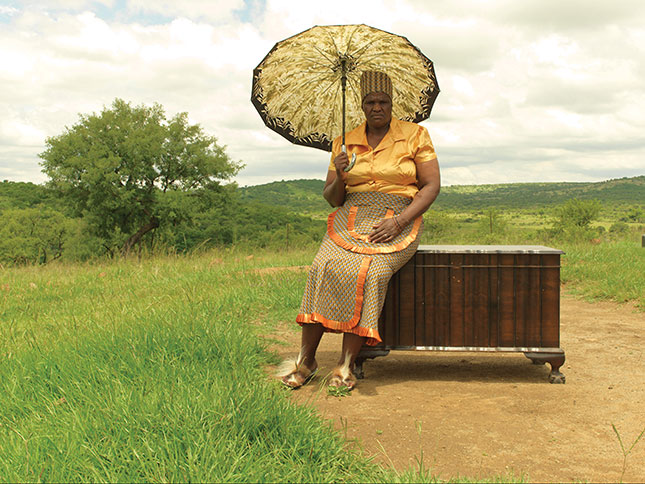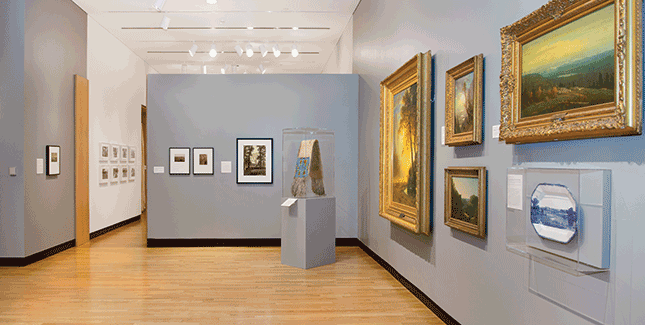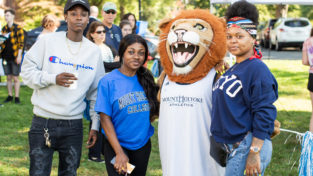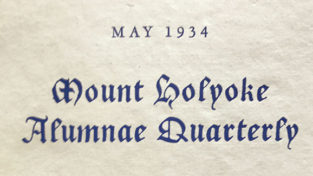An Eye to the Future
Recognized as one of the best college art museums in the nation, Mount Holyoke’s museum embarks on a new chapter, strengthened by an infusion of acquisitions that takes the institution’s mission of teaching with art to new heights
The Mount Holyoke College Art Museum’s recently completed 140 Gifts campaign—conceived by former director John Stomberg to solicit 140 new works for the collection in celebration of the anniversary—prompted such an outpouring of objects and acquisition funds from generous alumnae collectors and donors that the museum was able to meet its goal many times over, explains Interim Director and Weatherbie Curator of Education and Academic Programs Ellen Alvord ’89. Equally important, she says, the initiative allowed museum staff a valuable opportunity to think about how they wish to shape the permanent collection and continue integrating the museum into the College’s educational mission. “We’re entering a new chapter in the museum’s history and we’re eager to share,” says Alvord. “140 Unlimited—our yearlong, museum-wide exhibition and calendar of special events that kicked off September 6—is less about the history of the museum and more about the recent evolution of the collection.”
The influx of new objects into the collection—a range of gifts and acquisitions that numbers more than three hundred works—bolsters Mount Holyoke’s standing as a teaching museum, a concept that has gained increasing strength over the last few decades at colleges and universities around the country. The premise is straightforward: museum collections do not exist solely to delight; they should also challenge and inform.
Since launching the campaign in 2011, staff have delved deep into the museum’s holdings, identifying lacunae in the collection and seeking input from faculty and students as to their educational needs and interests. Former director John Stomberg set the stage for this new chapter on the museum’s 135th anniversary, says Alvord, and its conclusion dovetailed in late summer 2016 with the appointment of a new Florence Finch Abbott director, Tricia Y. Paik, an art historian and curator who has twenty-five years of experience in the art world and was most recently curator of contemporary art at the Indianapolis Museum of Art.
“It’s a very exciting time of new beginnings,” Alvord says. “Our faculty has expressed incredible interest in teaching through the use of visual and material culture, and the reinstallation of the museum with so many remarkable recent acquisitions has created new opportunities for engaging our campus and community visitors.”

Étienne Aubry (French, 1745–1781). Les Adieux de Coriolan à sa Femme au moment qu’il part pour se rendre chez les Volsques (Coriolanus Taking Leave of his Wife to Join the Volscians in their Attack upon Rome), ca. 1780. Oil on canvas. Purchase with funds given in honor of Helen Leidner Chaikin by her daughter Joyce Chaikin Ahrens (Class of 1962). 2014.32
A Rich History
From its earliest incarnation, Mount Holyoke has viewed its museum as an integral and dynamic player in student education. The College’s collection began to coalesce in the 1840s, when an assortment of a few hundred items from Africa, Asia, and the South Sea Islands arrived in South Hadley, sent by graduates of the Mount Holyoke Seminary for Women who were serving as teachers and missionaries in these far-flung locales. These objects were displayed in a cabinet in the original Seminary Building for students to study and enjoy. The administration’s actions were prescient; at the time, only a handful of other US colleges and universities—Dartmouth College (1769), Bowdoin College (1811), and Yale University (1832)—had already established an art gallery or museum.
In 1876 Mount Holyoke’s trustees officially established the art museum, and in the years following it continued to occupy a place of importance in the College’s educational mission. For the museum’s 1876 inaugural celebration, trustee wives Mrs. E.H. Sawyer and Mrs. A. Lyman Williston purchased Hetch Hetchy Canyon, a sweeping landscape painted the previous year by the renowned artist Albert Bierstadt. “In choosing a work of contemporary art, these donors were making a clear statement about what they thought was critically important for a museum within an institution with a rapidly expanding liberal arts curriculum,” notes Wendy Watson, the museum’s curator of forty-one years, who retired in June of 2015.
As the years passed, the collection continued to grow. Originally housed on the top floor of Williston Hall, in 1902 the museum moved into a dedicated space, the Dwight Memorial Art Building, and in the early 1970s, it moved once more to its current home, a designated building that also houses Gamble Auditorium and the art department’s offices and studios. By 1976, the museum’s centennial year, the collection contained 4,000 objects and was managed by the art department. It was around that time that Watson was hired as the first curator for a one-year term, tasked, says Alvord, with “getting things organized.” Instead, Watson guided the collection for the next four decades, overseeing a quadrupling of objects and setting the stage for teaching with art at a whole new level. “The ideal academic museum is a place where everyone is a student, where every visitor is engaged in the delight of looking, learning, and enjoying works of art from across the great span of cultures and time periods,” Alvord says. “It is a place for the production of knowledge, the exchange of ideas, and the expansion of consciousness—a place where you can exercise your eyes, your mind, and your creative sense, and when you leave, experience the world from a changed point of view.”

Kenneth Snelson (American, b. 1927). Wing 1, 1992. Stainless steel and wire. Gift of the artist. 2012.53
A Meaningful Expansion
This view has reaped great rewards. Today Mount Holyoke’s museum is recognized as among the finest college art museums in the country and contains some 24,000 objects thoughtfully gathered through a combination of acquisitions and generous gifts from alumnae, friends of alumnae, and other collectors who appreciate the museum’s commitment to teaching with art. “We’re recognized for having a broad, encyclopedic collection,” says Associate Curator Hannah Blunt, “but we’re also known for our significant ancient art collection as well as our extensive holdings of works on paper.” The collection is likewise distinguished by the fact that it’s a ‘collection of collections,’ Blunt points out. “We have a number of autonomous collections within our collection—the Joseph Allen Skinner Museum with its nearly 7,000 objects is the largest—but the early missionary gifts, the Fellows Collection of Silver and Snuff Bottles, and the Richter Collection of Netsuke are very important as well.”
In response to the 140 Gifts campaign, generous donors have strengthened the collection significantly, enabling the museum to add depth to virtually every facet of its holdings, Blunt notes. Among the many wonderful additions: a gold coin of the Roman Imperial period depicting Faustina the Elder, a purchase with funds from Susan B. Matheson ’68 in honor of Wendy Watson; an eighteenth-century French pastoral landscape given by Renee Scialom Cary ’48; a grand Neoclassical history painting, a purchase with funds from Joyce Chaikin Ahrens ’62; a collection of early-twentieth-century Pueblo ceramics from Juli Shea Towell ’55 and Gil Towell; major postwar sculptures from Shelby Baier White ’59, Linda Taft Litton ’58, and Astrid Rehl Baumgardner ’73; a number of marvelous works of contemporary photography, given by Jeffrey and Julie Lavin Loria ’86, Renee Conforte McKee ’62, Susan Abert Noonan ’82, and Jennifer Josselson Vorbach ’78; and a group of approximately two hundred vernacular photographs from Ann Zelle ’65. Important works were added in Asian ceramics and sculpture, fifteenth- to seventeenth-century European art, and contemporary printmaking as well.
Emma Kennedy ’16, who hopes to pursue a career in the arts, was a curatorial intern at the museum, working to catalogue Zelle’s photography collection, and is thrilled with the opportunity for hands-on experience with original objects. “My involvement with the museum has been hugely influential in the way I think about museums and art history,” says Kennedy, “and the exposure to original works of art has developed my analytical skills.”

Zwelethu Mthethwa (South African, b. 1960). Untitled, from the Hope Chest series, 2012. Digital C-print. Gift of Susan Abert Noonan (Class of 1982) in honor of her sister, Janice E. Abert (Class of 1982), for all she does for MHC. 2013.7.1
A Renewed Commitment
The success of the 140 Gifts campaign ensures that the museum is well placed to continue the College’s tradition of teaching with art, a commitment that has deepened significantly within the last decade. In 2009, explains Interim Director Alvord, Mount Holyoke received a $500,000 grant from the Andrew W. Mellon Foundation to “strengthen the academic role of the museum’s collections and programs.” Although the museum already enjoyed a reputation as a resource for innovative and interdisciplinary teaching on campus, the Mellon grant enabled the institution to enhance its offerings by funding the hiring of two additional full-time staff: a coordinator of academic programs and a curatorial assistant. When John Stomberg assumed the position as the Florence Finch Abbott Director in 2011, he continued the museum’s forward progress, lobbying enthusiastically for continued object-based learning initiatives within the Mount Holyoke community. “Wendy Watson was instrumental in securing the Mellon grant for the museum and really focused the staff on teaching with art, then John arrived and added even more energy to the initiative,” says Alvord. “John was passionate about teaching with art and quite a visionary. During his tenure, he built a strong following and reconnected with many of our alumnae, as well as helped secure two important grants from the Pierre and Tana Matisse Foundation to fund creativity and diversity initiatives. Our staff is committed to carrying out the mission that Wendy and John fostered.”
By all accounts, the return on this investment has been tremendous. In recent years, thousands of students have traded the traditional classroom for the gallery, conducting research on pieces in the museum’s archives and curating exhibitions. This year the museum’s assistant curator of education, Kendra Weisbin, also introduced a new Student Guide Program, enabling student volunteers to lead “Sightlines Tours,” which introduce visitors to the collection through individually created, theme-based tours such as “Seeing the Light” and “Visualizing the Sacred.”

Aisin Gioro Hongwu (Chinese, 1743–1811). Landscape in the style of Huang Gongwang, late 18th–early 19th century (Qing Dynasty, 1644–1911). Ink and colors on paper. Gift of Professor and Mrs. Po-zen Wong. 2014.38
English and sociology major and Frances Perkins scholar Chrissy Barney ’16 was among the students in the inaugural class of guides and says that her affiliation with the museum enhanced her time at Mount Holyoke immeasurably. “Creating and presenting my tour, ‘The Artist’s Perspective,’ was an incredibly rewarding experience. Speaking in public built my confidence, and working with original works of art kept me engaged in visual culture and helped me to think more creatively.”
Numerous faculty members—seventy-six in the 2014–2015 academic year—representing disciplines from English and religion to chemistry and mathematics have likewise turned to the collections to provide experiential learning for their students. “When I taught a standard biology course, I always included a laboratory component because hands-on experience is essential for mastering the subject,” observes emerita professor of biological sciences Susan Barry, who retired from the College in 2015 after twenty-three years of service. “Similarly, the Mount Holyoke College Art Museum served as my laboratory for teaching students about the neurobiological underpinnings of art, and the presence of the real items engages the students in a way that a PowerPoint display never could. At Mount Holyoke, we encourage our students to integrate the ideas they learn across many disciplines, and this partnership of art and science at the Museum has been a resounding success.”
Museum staff couldn’t be more delighted with the student engagement. “The Teaching with Art program has changed the way we think about the collections,” says Alvord, “not only in terms of subject matter but also in terms of transferable skills such as writing and critical thinking. It’s incredibly fulfilling to watch students thinking with objects.”
Blunt agrees. “Last year we had a class of first-year students in the museum studying entropy, which is a complicated subject. They examined a series of prints by Julie Mehretu—an Ethiopian-born, New York-based artist whose large-scale gestural paintings are distinguished by the ways in which they layer and compress time, space, and place through references to landscape, the built environment, diagramming, and mapping—and then gave presentations. Watching the students dig into a difficult mathematical concept through the study of art was just incredible.”

Kara Elizabeth Walker (American, b. 1969). Exodus of Confederates from Atlanta, from the series Harper’s Pictorial History of the Civil War (Annotated), 2005. Offset lithography and silkscreen on Somerset textured paper. Purchase with the Susan and Bernard Schilling (Susan Eisenhart, Class of 1932) Fund and the Belle and Hy Baier Art Acquisition Fund. 2012.14.9
A New Chapter
140 Unlimited opened as a museum-wide exhibition in early September and will remain on view for the next year. “The infusion of new objects has provided an invaluable opportunity for us to freshen our permanent collection galleries and also think carefully about the ways in which we integrate recent acquisitions into our exhibitions,” says Blunt, “and recently acquired objects are highlighted through graphics, many with extended labels.”
At least one special exhibition will also be built around a new holding in the collection. In the spring of 2017, Art Museum Advisory Board Fellow Taylor Anderson ’15, who majored in mathematics and art history with a concentration in Ancient Roman art and architecture, will curate an exhibition built around a recently acquired Roman Imperial bronze from the first- to second-century CE—Lar Holding a Patera and Cornucopia—a purchase with the Susan (Susan Eisenhart ’32) and Bernard Schilling Fund. The exhibition will focus on the lararium—a small room within the Roman home where the gods were worshipped and where the lar, a small domestic god, would have resided—and will include loans from nine prestigious collections and scholarly contributions by faculty in classics, history, and art history.
Exhibitions such as this are profoundly important to the museum’s mission, which encourages direct engagement with remarkable objects and works of art as key to pedagogical innovation. Says Paik, who will join the College in November, “I am truly honored to serve as the next director of the Mount Holyoke College Art Museum. It will be a privilege to work with faculty and museum staff in shaping dynamic and engaging programming for students, to inspire them to think originally and critically about art and material culture.”
—By Lori L. Ferguson
Lori L. Ferguson is a freelance writer based in southern New Hampshire. She enjoys writing on creativity in all its guises. Visit her website at writerloriferguson.com.
—Photos by Laura Shea, courtesy of the Mount Holyoke College Art Museum
This article appeared in the fall 2016 issue of the Alumnae Quarterly.
October 12, 2016











I love our MHC collection and want to share that my favorite gift from Mt Holyoke has been the calendar with pictures from the museum and which gave short descriptions of classes that were using the collection. That was my best “back to class” event and it happened every month!
An excellent article, which has me considering the disposition of my collection when I pass. My son, Thomas C. Moore of Cleveland, Ohio, is the executor of my will, and he has expressed interest in finding a suitable site for the pieces which consist of Native American and Colonial Hispanic pieces, as well as folk art from my years traveling the globe (see my web site http://www.sallymoore.com).
These are not tchotchkes but range from a 1920 Santa Ana Pueblo wedding vase, a signed and dated colored etching by Croatian master Josif Generalic, and a Siberian walrus tusk scrimshaw depicting ravens and foxes.
Living in the Southwest, I had considered placing the works in the Museum of International Folk Art in Santa Fe or our Albuquerque Museum, but Thom has expressed the feeling that they already have so much that the items would be better valued in a museum not so extensively endowed. He has some Ohio museums in mind, but my Holyoke connection has me wondering if this might not be a better choice. Let me know if there’s any interest.
An excellent article, which has me considering the disposition of my collection when I pass. My son, Thomas C. Moore of Cleveland, Ohio, is the executor of my will, and he has expressed interest in finding a suitable site for the pieces which consist of Native American and Colonial Hispanic pieces, as well as folk art from my years traveling the globe (see my web site http://www.sallymoore.com).
These are not tchotchkes but range from a 1920 Santa Ana Pueblo wedding vase, a signed and dated colored etching by Croatian master Josif Generalic, and a Siberian walrus tusk scrimshaw depicting ravens and foxes.
Living in the Southwest, I had considered placing the works in the Museum of International Folk Art in Santa Fe or our Albuquerque Museum, but Thom has expressed the feeling that they already have so much that the items would be better valued in a museum not so extensively endowed. He has some Ohio museums in mind, but my Holyoke connection has me wondering if this might not be a better choice. Let me know if there’s any interest.